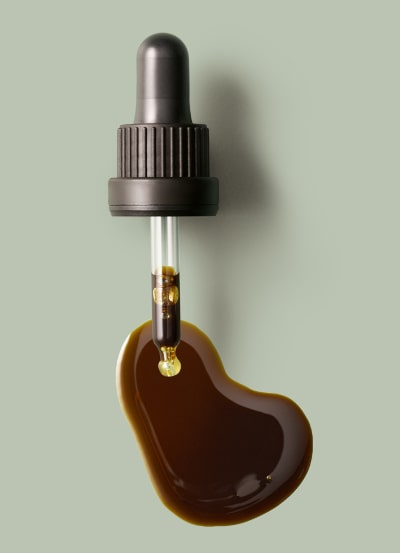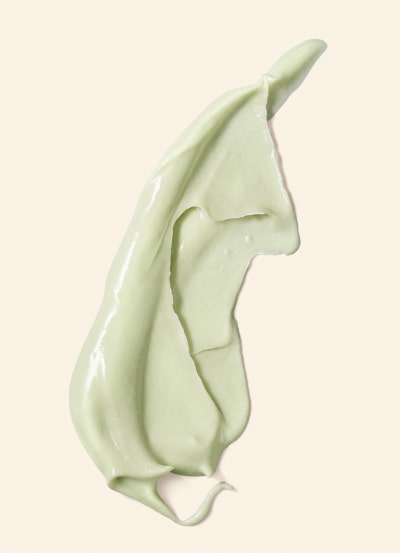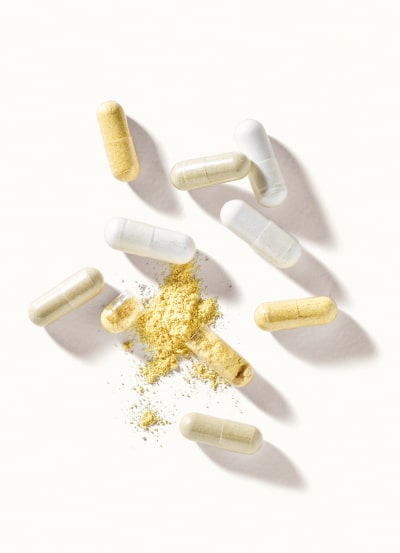BIOBLOOM HEMP FLOWER TEA
FOR GOOD AND RELAXING SLEEP
Take time for yourself with a cup of hemp flower tea and recharge your energy and power for the challenges of everyday life with a restful sleep. The unique organic hemp flower tea is the perfect support. BioBloom hemp flower tea is made exclusively from organic hemp flowers from the BioBloom fields that are harvested and processed by hand. This ensures the best quality flowers that contain the highest concentration of the valuable ingredients of the hemp plant. When infused in hot water, the hemp flower tea contains no THC and does not have any intoxicating effect. Depending on the infusion time, the unique hemp flower tea unfolds its multi-faceted effects.
MORNINGS
invigorating & vitalizing
Infusion time: 5 minutes

EVENINGS
calming & sleep promoting
Infusion time: 15 minutes


Organic Hemp Flower Tea
Tea box with 20 tea bags
BioBloom hemp flower tea is the perfect companion for a restful night’s sleep. Adequate sleep is essential for well-being and energy during the day. The main component in the unique organic hemp flower tea is the cannabinoid CBDa (cannabidiolic acid). It also contains valuable flavonoids and terpenes. The practical tea bags ensure the proper dose every time.
PREPARATION
Place a tea bag in a cup and pour in 200 ml of boiling water and let it steep for the desired effect (5 minutes for an invigorating and vitalizing effect or 15 minutes for a calming and sleep-promoting effect). Have a cup of tea an hour before going to bed to help you fall asleep easily and enjoy a good night’s sleep. The tea should still be warm.
INGREDIENTS
CBDa (cannabidiolic acid), flavonoids (apigenin, luteolin, quercetin, orientin, kaempferol, vitexin), polysaccharides, terpenes
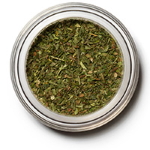

Organic Hemp Flower Tea
Tea box with 20 tea bags
BioBloom hemp flower tea is the perfect companion for a restful night’s sleep. Adequate sleep is essential for well-being and energy during the day. The main component in the unique organic hemp flower tea is the cannabinoid CBDa (cannabidiolic acid). It also contains valuable flavonoids and terpenes. The practical tea bags ensure the proper dose every time.
PREPARATION
Place a tea bag in a cup and pour in 200 ml of boiling water and let it steep for the desired effect (5 minutes for an invigorating and vitalizing effect or 15 minutes for a calming and sleep-promoting effect). Have a cup of tea an hour before going to bed to help you fall asleep easily and enjoy a good night’s sleep. The tea should still be warm.
INGREDIENTS
CBDa (cannabidiolic acid), flavonoids (apigenin, luteolin, quercetin, orientin, kaempferol, vitexin), polysaccharides, terpenes
Organic Hemp Flower Tea
bag, 50 g
Only the hand-picked hemp flowers from the certified organic BioBloom fields are used in our hemp flower tea. That is why our organic hemp flower tea should not be confused with ordinary hemp teas. The bag of tea is ideal for refilling our glass jar of organic hemp flower tea. For a good and restful night’s sleep, we also recommend supplementing your cup of tea with a BioBloom sleeping capsule Natural SLEEP.
PREPARATION
Place 2 teaspoons of loose tea in a cup and pour in 200 ml of boiling water and let steep for the desired effect (5 minutes for an invigorating and vitalizing effect or 15 minutes for a calming and sleep-promoting effect). Have a cup of tea an hour before going to bed to help you fall asleep easily and enjoy a good night’s sleep. The tea should still be warm.
INGREDIENTS
CBDa (cannabidiolic acid), flavonoids (apigenin, luteolin, quercetin, orientin, kaempferol, vitexin), polysaccharides, terpenes

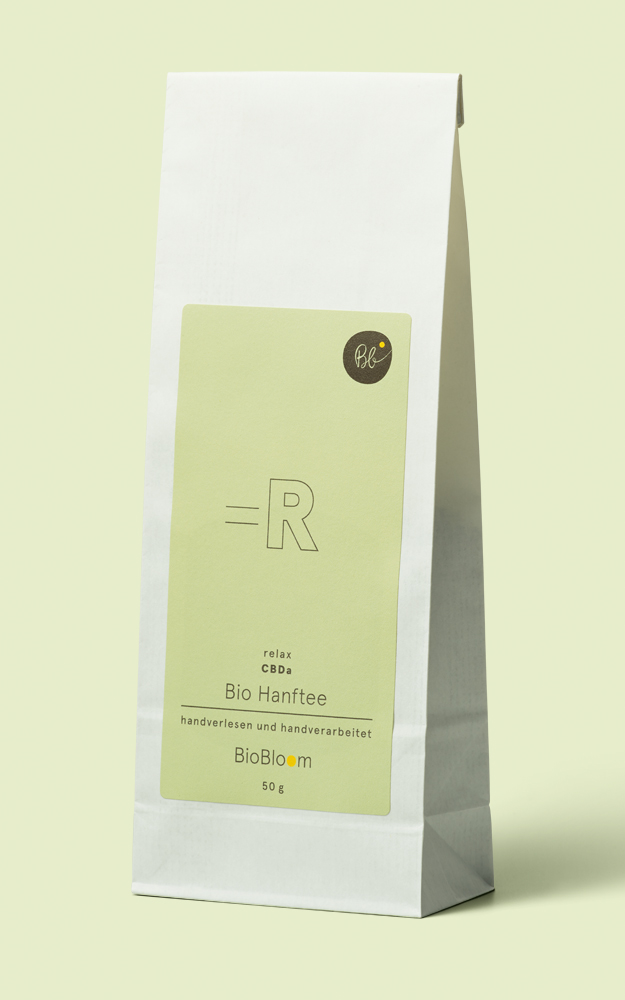

Organic Hemp Flower Tea
bag, 50 g
Only the hand-picked hemp flowers from the certified organic BioBloom fields are used in our hemp flower tea. That is why our organic hemp flower tea should not be confused with ordinary hemp teas. The bag of tea is ideal for refilling our glass jar of organic hemp flower tea. For a good and restful night’s sleep, we also recommend supplementing your cup of tea with a BioBloom sleeping capsule Natural SLEEP.
PREPARATION
Place 2 teaspoons of loose tea in a cup and pour in 200 ml of boiling water and let steep for the desired effect (5 minutes for an invigorating and vitalizing effect or 15 minutes for a calming and sleep-promoting effect). Have a cup of tea an hour before going to bed to help you fall asleep easily and enjoy a good night’s sleep. The tea should still be warm.
INGREDIENTS
CBDa (cannabidiolic acid), flavonoids (apigenin, luteolin, quercetin, orientin, kaempferol, vitexin), polysaccharides, terpenes
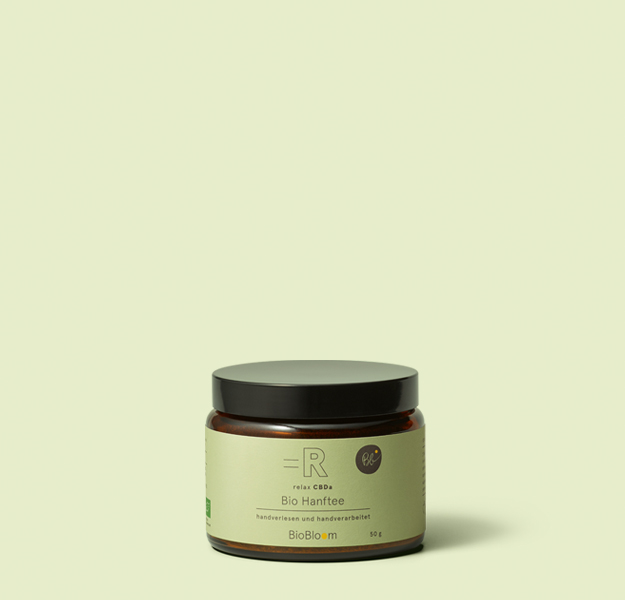
Organic Hemp Flower Tea
glass jar, 50g
The hemp flowers for the unique BioBloom hemp flower tea are carefully harvested by hand. Further processing is also carried out exclusively by hand in order to optimally preserve all the valuable ingredients of the hemp flowers. Enjoy more energy with a good night’s sleep. Your tea is sure to stay fresh for a long time in this high-quality glass jar with a tamper-proof lid.
PREPARATION
Place 2 teaspoons of loose tea in a cup and pour in 200 ml of boiling water and let steep for the desired effect (5 minutes for an invigorating and vitalizing effect or 15 minutes for a calming and sleep-promoting effect). Have a cup of tea an hour before going to bed to help you fall asleep easily and enjoy a good night’s sleep. The tea should still be warm.
INGREDIENTS
CBDa (cannabidiolic acid), flavonoids (apigenin, luteolin, quercetin, orientin, kaempferol, vitexin), polysaccharides, terpenes


Organic Hemp Flower Tea
glass jar, 50g
The hemp flowers for the unique BioBloom hemp flower tea are carefully harvested by hand. Further processing is also carried out exclusively by hand in order to optimally preserve all the valuable ingredients of the hemp flowers. Enjoy more energy with a good night’s sleep. Your tea is sure to stay fresh for a long time in this high-quality glass jar with a tamper-proof lid.
PREPARATION
Place 2 teaspoons of loose tea in a cup and pour in 200 ml of boiling water and let steep for the desired effect (5 minutes for an invigorating and vitalizing effect or 15 minutes for a calming and sleep-promoting effect). Have a cup of tea an hour before going to bed to help you fall asleep easily and enjoy a good night’s sleep. The tea should still be warm.
INGREDIENTS
CBDa (cannabidiolic acid), flavonoids (apigenin, luteolin, quercetin, orientin, kaempferol, vitexin), polysaccharides, terpenes

Artikel Ärztekrone
Die älteste medizinische Verwendung von Hanf geht auf den chinesischen Kaiser und Pflanzenforscher Shen Nung zurück. Bodenbeschaffenheit, Erntezeitpunkt, Witterung vor der Ernte und der Trocknungsprozess sind entscheidend für die Qualität von Cannabis. Blüten und Blätter unterscheiden sich vor allem bezüglich ihres Gehalts an Cannabinoiden, Polyphenolen und Terpenoiden. Gehalt und Zusammensetzung der Cannabinoide bzw. Terpenoide sind genetisch determiniert und für eine bestimmte Sorte spezifisch.
Cannabidiolsäure (CBDa)
Cannabidiolsäure (CBDa) ist das Hauptcannabinoid in frischem Hanf. Decarboxylierte Cannabinoide entstehen erst durch Erhitzen oder, sehr langsam, durch Alterung. Im Allgemeinen ist der Gehalt an Cannabinoiden in den Blüten am höchsten und nimmt in Richtung Wurzeln ab. Die Konzentration an Gesamt-CBD (CBDa + CBD) liegt bei 1–3% des Trockengewichtes, die von Gesamt-THC (THCa + THC) bei weniger als 0,1–0,2%. Selbst von nichtpsychoaktivem THCa werden in den Hanfblüten bestenfalls Spuren gefunden. Werden Hanfblüten oder -blätter mit kochendem Wasser aufgegossen, finden sich nach 10 bis 15 Minuten etwa 0,01–0,03 mg CBDa/ml als Hauptsubstanz. Temperatur und Dauer reichen nicht für eine nachweisbare Decarboxylierung aus. CBDa ist in zahlreichen Eigenschaften dem CBD ähnlich, ist jedoch im Gegensatz dazu ein selektiver COX-2-Inhibitor. In vitro zeigte CBDa antiinflammatorische, antimikrobielle und tumorinhibierende Eigenschaften, unterdrückte aber auch Übelkeit und Erbrechen. Die gleichzeitige Verabreichung mit CBD erhöhte dessen Bioverfügbarkeit um mehr als das Doppelte. CBDa könnte daher bei der Therapie mit CBD eine Rolle spielen.
Delta9-Tetrahydrocannabinolsäure
Delta9-Tetrahydrocannabinolsäure (THCa) ist etwa 3,7-mal besser wasserlöslich als THC. Selbst bei 20 Minuten Kochen im Wasser ist die Umwandlung von THCa in THC minimal. Aufgrund des bereits sehr niedrigen Gehalts an THCa in getrocknetem Hanf kann kein THC nachgewiesen werden. Hanftee ist daher völlig frei von psychoaktiven Stoffen. Im Gegensatz dazu fanden sich in aus medizinischem Cannabis/Marihuana zubereitetem Tee 100- bis 200-mal höhere Konzentrationen an THC mit 0,043 mg THCa/ml und 0,01 mg THC/ml. Der Gehalt an Terpenoiden steigt mit dem Gehalt von Cannabinoiden und beträgt etwa 3 bis 30 mg/g getrocknetem Pflanzenmaterial. Die Zusammensetzung der Terpene dient auch zur Charakterisierung bestimmter Cannabisbiotypen. Knospen und Blüten enthalten einen höheren Anteil der flüchtigen Monoterpene, während Blätter reicher an übel riechenden und schlecht bzw. bitter schmeckenden Sesquiterpenen sind. Unter den Monoterpenen sind ɑ-Terpineol, Linalool und Limonenoxid deutlich besser wasserlöslich (> 4,6 mmol/l) als ɑ,ß-Pinen, Limonen oder Myrcen (< 0,25 mmol/l); ß-Myrcen ist bei den meisten Cannabisstämmen das häufigste Terpen. Schmerzreduzierende Effekte wurden im Tierversuch bei einer Dosis von 10 und 20 mg i.p./kg beobachtet. Drogenhanf ist meist ärmer an Caryophyllenoxid, einem schlecht wasserlöslichen Sesquiterpen. Im Gegensatz zu Cannabinoiden sind Terpenoide in der normalen Nahrung weitverbreitet, insbesondere ß-Caryophyllen und ß-Caryophyllenoxid. Diese werden von der „Food and Drug Administration“ (FDA) und der „European Food Safety Authority“ (EFSA) als sicher eingestuft. Während des Trocknungsprozesses gehen vor allem Monoterpene verloren (–5 bis –10%); ein weiterer, allerdings wesentlich langsamerer, Verlust ist auch bei Lagerung zu beobachten.
Flavonoide in Hanfblütentee
Eine dritte Gruppe pflanzlicher Inhaltsstoffe mit positiven Eigenschaften auf den Organismus sind Polyphenole. Diese, darunter besonders Flavonoide, sind meist besser wasserlöslich als Terpenoide und werden daher in Hanfblütentee gefunden. Im Tierversuch zeigte ein Heißwasserextrakt eine mild sedierende Wirkung. Sowohl Cannabinoide wie Flavonoide sind ausgeprägte Antioxidanzien. Flavonoide sind im Pflanzenreich weitverbreitet. Etwa 23 Flavonoide sind in Cannabis bekannt, davon sind Cann(a)flavin A und Cann(a)flavin B hanfspezifisch. Nachdem vermutet wird, dass Flavonoide eine Schlüsselrolle beim Schutz gegen chronische Erkrankungen und Alterungsprozesse einnehmen, werden sie gegenwärtig intensiv auf verschiedene gesundheitliche Funktionen hin untersucht. Zahlreiche neue Erkenntnisse wurden erst in den letzten acht Jahren gewonnen. In einer epidemiologischen Studie war die tägliche Einnahme von 25,9 mg Flavonoiden (Quercetin, Kämpferol, Myricetin, Apigenin, Luteolin) mit einer signifikanten Abnahme des Krebsrisikos verbunden. Ähnliche Studien bestätigen diese Ergebnisse. Die Kombination verschiedener Cannabinoide und Flavonoide, aber auch Kombinationen mit anderen Substanzen erwiesen sich wiederholt als synergistisch. Studien mit relativ hohen Dosen von Einzelsubstanzen sind daher nicht maßgebend für Extrakte. Hanf zählt zu den Pflanzen mit dem höchsten Flavonoidgehalt sowie der höchsten antioxidativen Wirkung; der Gehalt erreicht etwa 2,5% des Trockengewichts. Eine Auswahl an Flavonoiden in Hanfblütentee und deren Eigenschaften findet sich in nebenstehender Tabelle. Es ist zu beachten, dass die beschriebenen Effekte in Tierversuchen mit Einzelsubstanzen und in deutlich höheren Dosen erzielt wurden als eine Einnahme mit Tee erwarten lässt. Bemerkenswert ist, dass nicht nur Cannabinoide und ß-Caryophyllen, sondern auch einige Flavonoide mit dem Endocannabinoidsystem interagieren. Quercetin beispielsweise aktiviert CB1-Rezeptoren und PPARgamma; Apigenin, Orientin und Quercetin inhibieren auch den Nuclear Transcription Factor NF-kB, einen der stärksten proinflammatorischen Transkriptionsfaktoren, der für die Induktion von proinflammatorischen Komponenten verantwortlich ist.
Zusammenfassend, der Konsum von Hanfblütentee, ergänzend zu Obst, Gemüse und einem gesunden Lebensstil, trägt sehr wahrscheinlich zur Aufrechterhaltung der Gesundheit bei.
Quelle: Ärztekrone 07/2017
bestätigte Wirkung
| Apigenin | anti-inflammatorisch, antiviral, Leber-protektiv, anti-diabetisch, anti-mutagen und Krebs-vorbeugend, | 18,20, 30,39; |
| Luteolin | Herz-stärkend, Leber-protektiv, wirkt einer Fettleibigkeit entgegen (unterdrückt Fettspeicherung), Knochen-Aufbau fördernd (steigert die Differenzierung von Osteoblasten) | 15,37, |
| Quercetin | Herz-stärkend / Herz-schützend, anti-inflammatorisch, anti-allergisch, antimutagen, Krebs-vorbeugend, Leber-protektiv, Dosis-abhängige Blutdrucksenkung, Angst-lösend, | 3,5,7,1324,28, 35, 37, |
| Orientin | Herz-schützend, radioprotectiv (bei nachfolgender Bestrahlung), neuro-protektiv, antidepressiv, wirkt einer Fettleibigkeit entgegen, antiviral, anti-bakteriell, antioxidativ, „antiaging“, anti-inflammatorisch, Gefäß-erweiternd, Schmerz-dämpfend, | 16,38, |
| Kaempferol | Krebs-vorbeugend, Herz-stärkend, anti-inflammatorisch, anti-viral, anti-bakteriell, wirkt gegen Protozoen in vivo; anti-diabetisch, neuroprotektiv, wirkt einer Fettleibigkeit entgegen, reduziert die Blutspiegel von Triglyceriden und Cholesterin, | 8, 17,18, |
| Vitexin | anti-inflammatorisch, Krebs-vorbeugend, Gedächnis-fördernd, anti-diabetisch, Herz-schützend, Blutdrucksenkung, antikonvulsiv, | 1,4 |
Sowohl Cannabinoide wie Flavonoide sind starke Antioxidantien.
Kombinationen verschiedener Flavonoide, aber auch Kombinationen mit anderen Substanzen haben sich als synergistisch erwiesen (15,16).
Der wässrige Extrakt (Tee) enthält wahrscheinlich weitere nützliche Verbindungen, wie Polysaccharide.
Es muss betont werden, dass jeder Hanf-Stamm eine ganz spezifische Zusammensetzung von Komponenten aufweist („chemischer Fingerabdruck“). Variiert bereits die chemische Zusammensetzung zwischen den Stämmen, insbesondere von Cannabinoiden und Flavonoiden, so variiert diese zusätzlich auch mit dem Wachstum, mit den verwendeten Pflanzenteilen und den Trocknungsbedingungen (2,10,11). BioBloom Tee ist somit einzigartig!
Zu beachten ist, dass nicht nur Cannabinoide, sondern auch Flavonoide mit vielen Komponenten des so genannten Endocannabinoidsystems (ECS) interagieren können. Quercetin aktiviert beispielsweise die CB1-Rezeptoren (24) und PPARg (21); Apigenin, Orientin und Quercetin hemmen auch den nuklearen Transkriptionsfaktor NF-kB (einer der stärksten pro-inflammatorischen Transkriptionsfaktoren), der auch für die Induktion von pro-inflammatorischen Verbindungen verantwortlich ist (3,20,30,38). Seit seiner Entdeckung in den 90-er Jahren wurde das Endocannabinoid-System als eines der wichtigsten Signal- und Regulationssysteme des Organismus erkannt. Die primäre Rolle des ECS ist es, physiologische Funktionen zu erhalten; kurz gesagt, die Gesundheit des Organismus.
In Summe trägt somit der regelmäßige Verzehr von BioBloom Hanfblütentee, kombiniert mit Früchten, Gemüse und einem gesunden Lebensstil, zum Schutz vor chronischen Krankheiten bei.
References:
- Abbasi E, Nassiri-Asl M, Sheikhi M, Shafiee M: , Effects of vitexin on scopolamine-induced memory impairment in rats. Chinese Journal of Physiology 2013;56(3): 184-189.
- Aizpurua-Olaizola O, Soydaner U, Öztürk E, et al: Evolution of the Cannabinoid and Terpene Content during the Growth of Cannabis sativa Plants from Different Chemotypes. J Nat Prod. 2016 Feb 26;79(2):324-331.
- Anhê GF, Okamoto MM, 2012, Kinote A, et al: Quercetin decreases inflammatory response and increases insulin action in skeletal muscle of ob/ob mice and in L6 myotubes. European J Pharmacology 2012;689:285–293.
- Aslam MS, Ahmad MS, Mamat AS: Pharmacological potential of vitexin. Indian Research J of Pharmacy and Science 2015, June; 2(2):114-122.
- Baghel SS, Shrivastava N, Baghel RS, et al: A review of quercetin: antioxidant and anticancer properties. World J Pharmacy and Pharmaceutical Sciences 2012;1(1):146-160.
- Bolognini D, Rock EM, Cluny NL, et al: Cannabidiolic acid prevents vomiting in Suncus murinus and nausea-induced behaviour in rats by enhancing 5-HT1A receptor activation. Br J Pharmacol 2013 Mar;168(6):1456-70.
- Brito Alves JL, Sousa V, Cavalcanti Neto MP, et al: New Insights on the Use of Dietary Polyphenols or Probiotics for the Management of Arterial Hypertension. Frontiers in Physiology 2016 October;Vol.7,Art.448, 8 pages.
- Calderón-Montaño JM, Burgos-Morón E, Pérez-Guerrero C, López-Lázaro M : A Review on the Dietary Flavonoid Kaempferol. Mini-Reviews in Medicinal Chemistry, 2011;11:298-344.
- Elzinga S, Fischedick J, Podkolinski R, Raber JC: Cannabinoids and Terpenes as Chemotaxonomic Markers in Cannabis. Nat Prod Chem Res 2015;3:181. doi:10.4172/2329-6836.1000181.
- Fournier G, Bausset J, Maciuk A, Thouminot C, Beherec O: Influence des conditions de séchage et de conservation des échantillons de chanvre prélevés dans les cultures industrielles afin d’en déterminer réglementairement la teneur en Δ-9-THC. [The influence of drying and storage conditions on collected samples of industrial hemp crops to determine regulatory levels of Δ-9-THC; article in French]. Ann Toxicol Anal. 2011; 23(2): 101-104.
- Kelly GS: Quercetin. Alternative Medicine Review 2011;16(2):172-194.Kumar S, Pandey AK: Chemistry and Biological Activities of Flavonoids: An Overview. The ScientificWorld Journal 2013; Article ID 162750, 16 pages.
- Kumar S, Pandey AK: Chemistry and Biological Activities of Flavonoids: An Overview. The ScientificWorld Journal 2013; Article ID 162750, 16 pages.
- Kwon SM, Kim S, Song NJ, et al : Antiadipogenic and proosteogenic effects of luteolin, a major dietary flavone, are mediated by the induction of DnaJ (Hsp40) Homolog, Subfamily B, Member 1. J Nutr Biochem. 2016 Apr;30:24-32.
- Lam KY, Ling APK, Koh RY, et al: 2016, A Review on Medicinal Properties of Orientin. Advances in Pharmacological Sciences 2016, Article ID 4104595, 9 pages.
- Montero M, Fuente S, Fonteriz RI, et al: Effects of Long-Term Feeding of the Polyphenols Resveratrol and Kaempferol in Obese Mice. PLoS ONE 2014 ;9(11): e112825. doi:10.1371/journal.pone.0112825.
- Namratha V, Merugu R, Devanuri N: Natural Products with Special Reference to Pharmacological Effects of Flavonoids: A Mini Review. Int J of PharmTech Research 2015;8(6): 26-31.
- Nash LA, Ward WE: Tea and Bone Health: Findings from Human Studies, Potential Mechanisms, and Identification of Knowledge Gaps. Crit Rev Food Sci Nutr. 2015 June 11;
- Omara EA, Kama A, Alqahtania A, et al: Herbal Medicines and Nutraceuticals for Diabetic Vascular Complications: Mechanisms of Action and Bioactive Phytochemicals. Current Pharmaceutical Design 2010; 16:3776-3807.
- Penumetcha M, Santanam N: Nutraceuticals as Ligands of PPARγ. PPAR Research 2012; Article ID 858352, 7 pages; doi:10.1155/2012/858352.
- Pickens JT: Sedative activity of cannabis in relation to its D-trans-tetrahydrocannabinol and cannabidiol content. Br J Pharmac. 1981;72:649-656.
- Politi M, Peschel W, Wilson N, et al: Direct NMR analysis of cannabis water extracts and tinctures and semi-quantitative data on D9-THC and D9-THC-acid. Phytochemistry 2008;69:562–570.
- Refolo MG, D’Alessandro R, Malerba N, et al: Anti Proliferative and Pro Apoptotic Effects of Flavonoid Quercetin Are Mediated by CB1 Receptor in Human Colon Cancer Cell Lines. J Cell Physiol. 2015 Dec;230(12):2973-2980.
- Rock EM, Limebeer CL, Navaratnam R, et al: A comparison of cannabidiolic acid with other treatments for anticipatory nausea using a rat model of contextually elicited conditioned gaping. Psychopharmacol (Berl) 2014 Aug;231(16):3207-15.
- Rock EM, Parker LA: Suppression of lithium chloride-induced conditioned gaping (a model of nausea-induced behaviour) in rats (using the taste reactivity test) with metoclopramide is enhanced by cannabidiolic acid. Pharmacol Biochem Behav. 2013 Oct;111:84-89.
- Ruhaak LR, Felth, J., Karlsson, P.C., Rafter, J.J., Verpoorte, R., Bohlin L: Evaluation of the cyclooxygenase inhibiting effects of six major cannabinoids isolated from Cannabis sativa. Pharm. Bull. 2011; 34:774–778.
- Serban MC, Effects of Quercetin on Blood Pressure: A Systematic Review and Meta-Analysis of Randomized Controlled Trials. J Am Heart Assoc. 2016; Jul 12;5(7), 22 pages. pii: e002713. doi: 10.1161/JAHA.115.002713.
- Shen CL, Chyu MC: Tea flavonoids for bone health: from animals to humans. J Investigative Medicine 2016;64(7):1151-1157.
- Shukla S, Gupta S: 2010, Apigenin: A Promising Molecule for Cancer Prevention. Pharm Res. 2010 June ; 27(6): 962–978.
- Srivastava N, Chauhan AS, Sharma B: Isolation and characterization of some phytochemicals from Indian traditional plants. Biotechnology Research International Volume 2012, Article ID 549850, 8 pages; doi:10.1155/2012/549850.
- Takeda S, Okazaki H, Kohro-Ikeda E, et al : DNA microarray analysis of genes in highly metastatic 4T1E/M3 murine breast cancer cells following exposure to cannabidiolic acid. Fundamental Toxicological Sciences 2015;2(2):89-94.
- Takeda S, Okajima S, Miyoshi H, et al: Cannabidiolic acid, a major cannabinoid in fiber-type cannabis, is an inhibitor of MDA-MB-231 breast cancer cell migration. Toxicology Letters 2012 Nov 15;214(3):314-319.
- Takeda S, Misawa K, Yamamoto I, Kazuhito WatanabeK: Cannabidiolic Acid as a Selective Cyclooxygenase-2 Inhibitory Component in Cannabis. Drug Metabolism and Disposition 2008;36(9):1917-1921.
- Valavanidis A, Vlachogianni T: Plant Polyphenols. Recent Advances in Epidemiological Research and Other Studies on Cancer Prevention. In: Studies in Natural Products Chemistry, Bioactive Natural Products, Vol. 39, Chap.8, pp.269-295. Ed. Atta-Ur-Rahman FRS; Elsevier Science, Amsterdam 2013.
- Wang M, Wang YH, Avula B, et al: Decarboxylation Study of Acidic Cannabinoids: A Novel Approach Using Ultra-High-Performance Supercritical Fluid Chromatography/Photodiode Array-Mass Spectrometry. Cannabis and Cannabinoid Research 2016;1(1), 10 pages; DOI: 10.1089/can.2016.0020.
- Weiskirchen R: Hepatoprotective and Anti-fibrotic Agents: It’sTime to Take the Next Step. Frontiers in Pharmacology 2015; 6: 303; 40 pages.
- Xiao Q, Qu Z, Zhao Y, et al: Orientin Ameliorates LPS-Induced Inflammatory Responses through the Inhibitory of the NF-kB Pathway and NLRP3 Inflammasome. Evidence-Based Complementary and Alternative Medicine, Volume 2017, Article ID 2495496, 8 pages.
- Zhang W, Qiao H, Lv Y, et al: Apigenin Inhibits Enterovirus-71 Infection by Disrupting Viral RNA Association with trans-Acting Factors. PLoS ONE 2014;9(10): e110429. doi:10.1371/journal.pone.0110429.
Download Analyse-Ergebnisse
Download Artikel Ärztekrone
Das Material auf dieser Website ist urheberrechtlich geschützt.
Jede Verwendung, sei es das Ganze oder Teile – oder jede andere Form der Nutzung, auch in elektronischer Form, ist nur mit der schriftlichen Zustimmung von BioBloom erlaubt.
